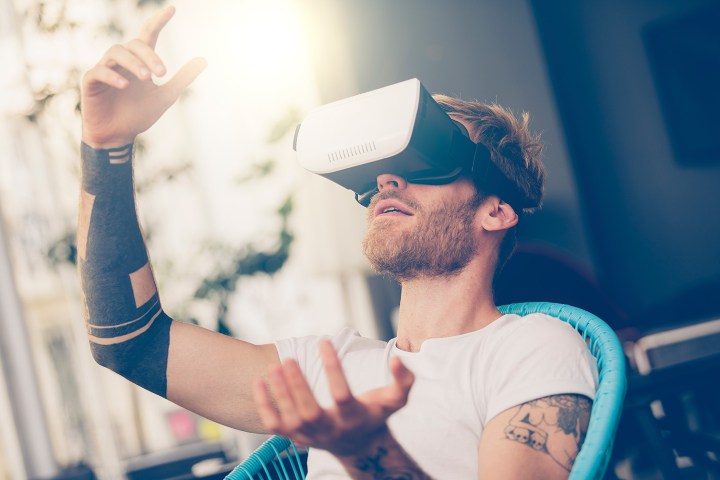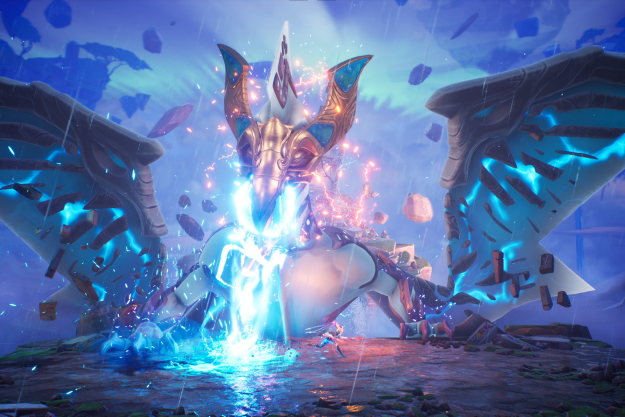
Augmented reality comprises a wide variety of technologies and experiences, from the creatures floating around your smartphone camera image in Pokémon Go to the work enterprising developers are doing with Microsoft’s head-mounted HoloLens. Where virtual reality obfuscates the real world to create digital spaces, AR encompasses and includes the real world. It lays virtual images over real ones, creating the potential for experiences that are very different from those possible in VR.
Unity maintains that a majority percentage of VR developers use Unity’s engine, but the company’s chief marketing officer, Clive Downie, is among those who believe AR will ultimately be bigger. The reasons for that belief are manifold, so we chatted with Downie and several AR developers at the Vision summit to find out exactly how and why AR will win in the end.
Opposing forces
“AR is going to be more mass adopted in my opinion, and VR is going to be something that people want to fully immerse in for deeply immersive experiences in the comfort of a contained space,” Downie said. “I think AR is really going to be where the mass adoption comes, because you’re going to be able to power a lot more experiences that just augment people’s worlds.”

“VR hasn’t run its course yet,” Downie added. “I think it’s hard for the creative world, and it’s hard for the consumer world, to comprehend two earth-shattering technologies at the same time. I think VR needs to be matured, and then AR will become matured behind it.”
VR is sexy right now because it’s incensed the gaming world, but AR’s reach is potentially far wider than just entertainment. Jay Wright, president of AR technology platform company Vuforia, said augmented reality will catch on first in workplaces and business settings before seeing wide adoption.
“I think there was a great perfect storm for VR that has led to a tremendous amount of investment for, you know, the next version of gaming. I don’t think AR’s had that moment,” Wright said. “Right now AR is kind of this fragmented collection of things that are happening on phones and forward-looking stuff that’s happening for eyewear, but it’s still kind of caught in the enterprise, and just has not had that moment. But it will. It absolutely will.”
That moment may happen gradually, or it may come all at once like VR’s rise thanks to the Oculus Rift a few years ago. “It’s probably a couple of years before these things are pervasive in enterprise use,” Wright said. “Maybe you see people at the grocery store or Home Depot or delivery people that have something on, and then it’s some time after that where it becomes more pervasive with consumers … I think that’s how people get used to it, and that’s probably how they’re going to get comfortable with how ridiculous we might look wearing something that is a little more substantial than what glasses look like today.”
“I think it’s hard for the world to comprehend two earth-shattering technologies at the same time.”
Vuforia has been working with augmented reality since 2009, when the company was a division of Qualcomm. At the Vision conference, Vuforia showed off its Smart Terrain tools, which help AR devices map and understand the real world to better integrate them with the digital. Wright gave several examples of AR already in use today, from IKEA’s virtual furniture app to the magnifying glass-shaped MAGNEO, a unique children’s toy and learning tool from Chinese company Neobear. Where VR is inherently limited — “a largely sedentary kind of experience,” Wright said — the possibilities with AR are endless.
“If the industry is successful in developing this class of device that goes on our head and delivers the class of experience that we all expect … this is the last device that most people need to buy, because if we’re successful in doing this there’s not needs for screens on anything else,” he said. Wright envisioned a future where all screens — from your TV to your laptop to a projector displaying PowerPoint slides on a meeting room wall — are virtual displays on AR headsets. “If you believe that version of the movie, this new platform, this eventual platform on our heads, is sort of the last one we need. It could be the platform to end them all.”
A gradual rise
Jack Brewitt, business development director at AR toy maker SwapBots, thinks AR’s rise will be gradual but monumental. “It’ll be a normal thing over the next couple of years,” he said. “I mean, Snapchat, they use AR. No one talks about it, because it’s just filters and you make funny faces and whatever else.”

In March, 2017, SwapBots concluded a successful Kickstarter campaign for its AR toys, which use real plastic figurines and a smartphone app to project virtual creatures for kids to create, play with and battle. They’ve worked closely with Vuforia for technology and support, and Brewitt shares Wright’s views on the future.
“I don’t believe VR is the next step in technology,” Brewitt said. “I believe that it is a step, but I believe that the thing after that is AR, because AR unlocks everything and VR is still — it’s enclosed.” Whereas AR is open to the real world — “this very, very easy experience that children can understand, that everyone can see and everyone be part of,” Brewitt said — and that makes all the difference.
But are AR and VR really so different? One demo at the Vision summit, Heroes: An Immersive Dance Experience, used both: A VR portion where you watch two dancers writhe to David Bowie’s song Heroes, and a subsequent AR epilogue where you see the dancers from different perspectives as you walk around a carefully laid out real-world room wearing a HoloLens headset. You even hold the dancers in your hand at one point, and it’s almost like you can feel their tiny feet.
The lead creative technologist on Heroes’ AR section, Thomas Wester, believes the two new technologies will ultimately merge, with headsets that are fully capable of doing either. “I feel like AR is just going to be VR with the blinds down,” he said. “The way you make for them, the content creation, I feel can be pretty similar.”
“[AR] might never experience the lightning-strike boom that has propelled virtual reality in the last few years, but it may catch on in meeting rooms”
AR and VR are currently considered separate spaces mostly due to technological limits, Wester said. Another project he’s working on, also by Heroes co-creators MAP Design Lab and Creative Director Melissa Painter, lets users explore a virtual version of Utah’s Zion National Park from downtown Chicago. That requires users to hold up their phones and view the world through their rectangular screens, “because that’s where we’re at with the tech right now,” Wester said.
That said, “our phones are getting more and more capable,” Wester added, and “that’s a great spot to start with AR, and as the sensors on the phones get better and the cameras are better, there’s depth sensors, there’s multiple sensors — the better we can see and understand the world from a technical perspective, the more we can play with that world.”
Augmented reality might never experience the lightning-strike boom that has propelled virtual reality in the last few years, but it may catch on in meeting rooms, or in warehouses, or the grocery store down the street. The technology will continue to gradually improve, and soon Snapchat filters and superimposed Pokémon won’t be the only everyday AR in use. That’s according to these developers, at least. For now, they’re happy to let VR have its moment in the spotlight. They believe the future is theirs.
Editors' Recommendations
- Marvel World of Heroes is the next AR game from Pokémon Go studio
- Pokémon Go creators announce Pikmin augmented-reality game
- Why confidence in VR is rising — and Oculus Quest is to thank
- Microsoft patents a virtual reality floor mat that could be paired with an Xbox
- YouTube VR app to bring more than 1 million experiences to Oculus Quest at launch


